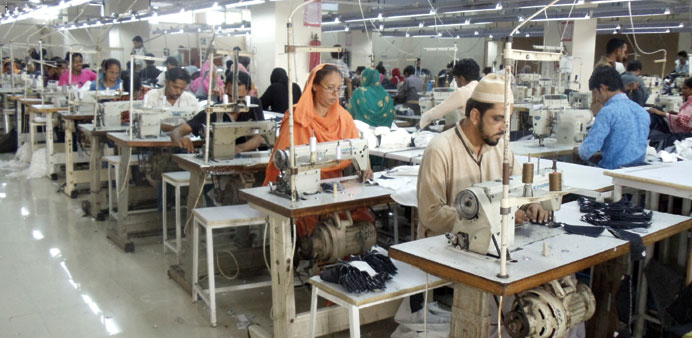A garment factory in Karachi. Standard & Poor’s yesterday raised Pakistan’s outlook as lower energy costs and an IMF loan boost growth and improve finances.
Bloomberg/Karachi
Standard & Poor’s raised Pakistan’s credit rating outlook to positive from stable, as lower energy costs and an IMF loan boost growth and improve finances.
“The positive outlook reflects our expectations of Pakistan’s improved economic growth prospects, fiscal and external performance, and the supportive relationship of external donors over the next 12 months,” S&P said in a statement yesterday.
It affirmed its B- rating, which is among the so-called junk grades, and raised the 2015-2017 average growth projection to 4.6% from 3.8%. Risks include higher oil prices, weakness in key trading partners and violence, S&P said.
The move follows a similar step by Moody’s Investors Service in March as Prime Minister Nawaz Sharif looks to resolve Pakistan’s crippling power shortages and boost investment. The nation’s foreign exchange reserves have almost doubled to $12.6bn with the help of an International Monetary Fund loan and its stocks are among Asia’s best performers this quarter.
“Foreign inflows can be expected in the country and more dollars would mean more economic stability,” Saad Khan, an economist at Arif Habib said by phone from Karachi after the upgrade. The benchmark KSE100 index has risen 10.7% this quarter, trailing only Chinese and Hong Kong equities, according to data compiled by Bloomberg. The gauge fell 0.8% as of 12:24 pm in Karachi yesterday and Pakistan’s rupee was little changed.
China pledged $45bn for roads, ports and power plants when President Xi Jinping visited Pakistan last month. The planned investment, 28 times more than the foreign direct investment Pakistan received in year ended June, will spur investment activity and help ease the country’s growing energy shortage, Moody’s said in a report on Monday.
Pakistan took a $6.6bn loan from the IMF in 2013 to avert a balance-of-payments crisis and has cleared six programme reviews. Oil prices have fallen 38% over the past year, lowering Pakistan’s import bill, easing price pressures and giving the central bank room to cut interest rates.
S&P forecasts Pakistan will report an average budget deficit of 3.5% of gross domestic product during 2016-2019 with interest costs falling to about 25.5% of revenues from an estimated 30.6% in 2015. Inflation is expected to average 4.8% over
2015-2019.



